Acoustic Signals and Behavior of the Invasive Freshwater Crayfish Cherax destructor (Clark, 1936)
Abstract
:1. Introduction
2. Materials and Methods
2.1. Collection and Housing of Animals
2.2. Experimental Setup
2.3. Acoustic-Video Monitoring System and Analysis
- Behavioral events: acoustic signals, tail flips, encounters, fights;
- Behavioral states: fights’ duration, velocity of movement, distance moved, angular velocity, proximity.
2.4. Statistical Analysis
3. Results
3.1. Acoustic Signals
3.2. Behavioral Events and States
3.3. Acoustic and Behavior Association
4. Discussion
5. Conclusions
Supplementary Materials
Author Contributions
Funding
Institutional Review Board Statement
Informed Consent Statement
Data Availability Statement
Acknowledgments
Conflicts of Interest
References
- Buscaino, G.; Ceraulo, M.; Pieretti, N.; Corrias, V.; Farina, A.; Filiciotto, F.; Maccarrone, V.; Grammauta, R.; Caruso, F.; Alonge, G.; et al. Temporal patterns in the soundscape of the shallow waters of a Mediterranean marine protected area. Sci. Rep. 2016, 6, 34230. [Google Scholar] [CrossRef]
- Caruso, F.; Alonge, G.; Bellia, G.; De Domenico, E.; Grammauta, R.; Larosa, G.; Mazzola, S.; Riccobene, G.; Pavan, G.; Papale, E.; et al. Long-Term Monitoring of Dolphin Biosonar Activity in Deep Pelagic Waters of the Mediterranean Sea. Sci. Rep. 2017, 7, 4321. [Google Scholar] [CrossRef] [PubMed]
- Higgs, D.M.; Humphrey, S.R. Passive acoustic monitoring shows no effect of anthropogenic noise on acoustic communication in the invasive round goby (Neogobius melanostomus). Freshw. Biol. 2018, 65, 66–74. [Google Scholar] [CrossRef]
- Gregorietti, M.; Papale, E.; Ceraulo, M.; de Vita, C.; Pace, D.S.; Tranchida, G.; Mazzola, S.; Buscaino, G. Acoustic Presence of Dolphins through Whistles Detection in Mediterranean Shallow Waters. J. Mar. Sci. Eng. 2021, 9, 78. [Google Scholar] [CrossRef]
- Abrahams, M.V.; Kattenfeld, M.G. The role of turbidity as a constraint on predator-prey interactions in aquatic environments. Behav. Ecol. Sociobiol. 1997, 40, 169–174. [Google Scholar] [CrossRef]
- Frommen, J.G. Aggressive communication in aquatic environments. Funct. Ecol. 2019, 34, 364–380. [Google Scholar] [CrossRef]
- Buscaino, G.; Ceraulo, M.; Canale, D.; Papale, E.; Marrone, F. First evidence of underwater sounds emitted by the living fossils Lepidurus lubbocki and Triops cancriformis (Branchiopoda: Notostraca). Aquat. Biol. 2021, 30, 101–112. [Google Scholar] [CrossRef]
- Salmon, M.; Atsaides, S.P. Visual and Acoustical Signalling during Courtship by Fiddler Crabs (GenusUca). Am. Zool. 1968, 8, 623–639. [Google Scholar] [CrossRef]
- Amorim, M.C.P.; Vasconcelos, R.O. Variability in the mating calls of the Lusitanian toadfish Halobatrachus didactylus: Cues for potential individual recognition. J. Fish Biol. 2008, 73, 1267–1283. [Google Scholar] [CrossRef]
- Buscaino, G.; Gavio, A.; Galvan, D.; Filiciotto, F.; Maccarrone, V.; de Vincenzi, G.; Mazzola, S.; Orensanz, J. Acoustic signals and behaviour of Ovalipes trimaculatus in the context of reproduction. Aquat. Biol. 2015, 24, 61–73. [Google Scholar] [CrossRef]
- Filiciotto, F.; Moyano, M.P.S.; Hidalgo, F.; de Vincenzi, G.; Bazterrica, M.C.; Ceraulo, M.; Corrias, V.; Quinci, E.M.; Lorusso, M.; Mazzola, S.; et al. Underwater acoustic communication during the mating behaviour of the semi-terrestrial crab Neohelice granulata. Sci. Nat. 2019, 106, 35. [Google Scholar] [CrossRef] [PubMed]
- Simões, J.M.; Duarte, I.G.; Fonseca, P.J.; Turner, G.F.; Amorim, M.C. Courtship and agonistic sounds by the cichlid fish Pseudotropheus zebra. J. Acoust. Soc. Am. 2008, 124, 1332–1338. [Google Scholar] [CrossRef] [PubMed]
- Ceraulo, M.; Moyano, M.P.S.; Bazterrica, M.C.; Hidalgo, F.J.; Snitman, S.; Papale, E.; Buscaino, G.; Gavio, M.A. Agonistic Behaviour and Sound Production during Male–Male Varunid Crabs (Cyrtograpsus angulatus, Dana 1851) Encounters. J. Mar. Sci. Eng. 2022, 10, 1370. [Google Scholar] [CrossRef]
- Herzing, D. Synchronous and Rhythmic Vocalizations and Correlated Underwater Behavior of Free-ranging Atlantic Spotted Dolphins (Stenella frontalis) and Bottlenose Dolphins (Tursiops truncatus) in the Bahamas. Anim. Behav. Cogn. 2015, 2, 14–29. [Google Scholar] [CrossRef]
- Van Oosterom, L.; Montgomery, J.C.; Jeffs, A.G.; Radford, C.A. Evidence for contact calls in fish: Conspecific vocalisations and ambient soundscape influence group cohesion in a nocturnal species. Sci. Rep. 2016, 6, 19098. [Google Scholar] [CrossRef]
- Papale, E.; Fanizza, C.; Buscaino, G.; Ceraulo, M.; Cipriano, G.; Crugliano, R.; Grammauta, R.; Gregorietti, M.; Renò, V.; Ricci, P.; et al. The Social Role of Vocal Complexity in Striped Dolphins. Front. Mar. Sci. 2020, 7, 584301. [Google Scholar] [CrossRef]
- Jeffs, A.; Tolimieri, N.; Montgomery, J.C. Crabs on cue for the coast: The use of underwater sound for orientation by pelagic crab stages. Mar. Freshw. Res. 2003, 54, 841–845. [Google Scholar] [CrossRef]
- Celi, M.; Filiciotto, F.; Parrinello, D.; Buscaino, G.; Damiano, A.; Cuttitta, A.; D’Angelo, S.; Mazzola, S.; Vazzana, M. Physiological and agonistic behavioural response of Procambarus clarkii to an acoustic stimulus. J. Exp. Biol. 2012, 216, 709–718. [Google Scholar] [CrossRef]
- Celi, M.; Filiciotto, F.; Vazzana, M.; Arizza, V.; Maccarrone, V.; Ceraulo, M.; Mazzola, S.; Buscaino, G. Shipping noise affecting immune responses of European spiny lobster (Palinuruselephas). Can. J. Zool. 2015, 93, 113–121. [Google Scholar] [CrossRef]
- Filiciotto, F.; Vazzana, M.; Celi, M.; Maccarrone, V.; Ceraulo, M.; Buffa, G.; Di Stefano, V.; Mazzola, S.; Buscaino, G. Behavioural and biochemical stress responses of Palinurus elephas after exposure to boat noise pollution in tank. Mar. Pollut. Bull. 2014, 84, 104–114. [Google Scholar] [CrossRef]
- Filiciotto, F.; Vazzana, M.; Celi, M.; Maccarrone, V.; Ceraulo, M.; Buffa, G.; Arizza, V.; de Vincenzi, G.; Grammauta, R.; Mazzola, S.; et al. Underwater noise from boats: Measurement of its influence on the behaviour and biochemistry of the common prawn (Palaemon serratus, Pennant 1777). J. Exp. Mar. Biol. Ecol. 2016, 478, 24–33. [Google Scholar] [CrossRef]
- Vazzana, M.; Ceraulo, M.; Mauro, M.; Papale, E.; Dioguardi, M.; Mazzola, S.; Arizza, V.; Chiaramonte, M.; Buscaino, G. Effects of acoustic stimulation on biochemical parameters in the digestive gland of Mediterranean mussel Mytilus galloprovincialis (Lamarck, 1819). J. Acoust. Soc. Am. 2020, 147, 2414–2422. [Google Scholar] [CrossRef] [PubMed]
- Vazzana, M.; Mauro, M.; Ceraulo, M.; Dioguardi, M.; Papale, E.; Mazzola, S.; Arizza, V.; Beltrame, F.; Inguglia, L.; Buscaino, G. Underwater high frequency noise: Biological responses in sea urchin Arbacia lixula (Linnaeus, 1758). Comp. Biochem. Physiol. Part A Mol. Integr. Physiol. 2020, 242, 110650. [Google Scholar] [CrossRef]
- Mauro, M.; Pérez-Arjona, I.; Perez, E.J.B.; Ceraulo, M.; Bou-Cabo, M.; Benson, T.; Espinosa, V.; Beltrame, F.; Mazzola, S.; Vazzana, M.; et al. The effect of low frequency noise on the behaviour of juvenile Sparus aurata. J. Acoust. Soc. Am. 2020, 147, 3795–3807. [Google Scholar] [CrossRef]
- Solé, M.; Kaifu, K.; Mooney, T.A.; Nedelec, S.L.; Olivier, F.; Radford, A.N.; Vazzana, M.; Wale, M.A.; Semmens, J.M.; Simpson, S.D.; et al. Marine invertebrates and noise. Front. Mar. Sci. 2023, 10, 1129057. [Google Scholar] [CrossRef]
- Popper, A.N.; Salmon, M.; Horch, K.W. Acoustic detection and communication by decapod crustaceans. J. Comp. Physiol. A 2001, 187, 83–89. [Google Scholar] [CrossRef]
- Nakamachi, T.; Ishida, H.; Hirohashi, N. Sound Production in the Aquatic Isopod Cymodoce japonica (Crustacea: Peracarida). Biol. Bull. 2015, 229, 167–172. [Google Scholar] [CrossRef]
- Guinot-Dumortier, D.; Dumortier, B. La Stridulation Chez Les Crabes. Crustaceana 1960, 1, 117–155. [Google Scholar] [CrossRef]
- Boon, P.; Yeo, D.; Todd, P. Sound production and reception in mangrove crabs Perisesarma spp. (Brachyura: Sesarmidae). Aquat. Biol. 2009, 5, 107–116. [Google Scholar] [CrossRef]
- Buscaino, G.; Filiciotto, F.; Gristina, M.; Bellante, A.; Buffa, G.; Di Stefano, V.; Maccarrone, V.; Tranchida, G.; Mazzola, S. Acoustic behaviour of the European spiny lobster Palinurus elephas. Mar. Ecol. Prog. Ser. 2011, 441, 177–184. [Google Scholar] [CrossRef]
- Moyano, M.P.S.; Ceraulo, M.; Mazzola, S.; Buscaino, G.; Gavio, M.A. Sound production mechanism in the semiterrestrial crab Neohelice granulata (Brachyura, Varunidae). J. Acoust. Soc. Am. 2019, 146, 3466–3474. [Google Scholar] [CrossRef] [PubMed]
- Au, W.W.L.; Banks, K. The acoustics of the snapping shrimp Synalpheus parneomeris in Kaneohe Bay. J. Acoust. Soc. Am. 1998, 103, 41–47. [Google Scholar] [CrossRef]
- Versluis, M.; Schmitz, B.; von der Heydt, A.; Lohse, D. How Snapping Shrimp Snap: Through Cavitating Bubbles. Science 2000, 289, 2114–2117. [Google Scholar] [CrossRef]
- Henninger, H.P.; Watson, W.H. Mechanisms underlying the production of carapace vibrations and associated waterborne sounds in the American lobster, Homarus americanus. J. Exp. Biol. 2005, 208, 3421–3429. [Google Scholar] [CrossRef] [PubMed]
- Breithaupt, T.; Tautz, J. The Sensitivity of Crayfish Mechanoreceptors to Hydrodynamic and Acoustic Stimuli. In Frontiers in Crustacean Neurobiology; Wiese, K., Krenz, W.-D., Tautz, J., Reichert, H., Mulloney, B., Eds.; Birkhäuser: Basel, Switzerland, 1990; pp. 114–120. [Google Scholar] [CrossRef]
- Jézéquel, Y.; Jones, I.T.; Bonnel, J.; Chauvaud, L.; Atema, J.; Mooney, T.A. Sound detection by the American lobster (Homarus americanus). J. Exp. Biol. 2021, 224, jeb240747. [Google Scholar] [CrossRef]
- Tautz, J.; Sandeman, D.C. The Detection of Waterborne Vibration by Sensory Hairs on the Chelae of the Crayfish. J. Exp. Biol. 1980, 88, 351–356. [Google Scholar] [CrossRef]
- Bouwma, P.E.; Herrnkind, W.F. Sound production in Caribbean spiny lobster Panulirus argus and its role in escape during predatory attack by Octopus briareus. N. Z. J. Mar. Freshw. Res. 2009, 43, 3–13. [Google Scholar] [CrossRef]
- Buscaino, G.; Filiciotto, F.; Buffa, G.; Di Stefano, V.; Maccarrone, V.; Buscaino, C.; Mazzola, S.; Alonge, G.; D’angelo, S. The underwater acoustic activities of the red swamp crayfish Procambarus clarkii. J. Acoust. Soc. Am. 2012, 132, 1792–1798. [Google Scholar] [CrossRef]
- Clayton, D. Singing and dancing in the ghost crab Ocypode platytarsus (Crustacea, Decapoda, Ocypodidae). J. Nat. Hist. 2008, 42, 141–155. [Google Scholar] [CrossRef]
- Flood, A.S.; Goeritz, M.L.; Radford, C.A. Sound production and associated behaviours in the New Zealand paddle crab Ovalipes catharus. Mar. Biol. 2019, 166, 162. [Google Scholar] [CrossRef]
- Breithaupt, T. Sound Perception in Aquatic Crustaceans. In The Crustacean Nervous System; Wiese, K., Ed.; Springer: Berlin/Heidelberg, Germany, 2002; pp. 548–558. [Google Scholar] [CrossRef]
- Favaro, L.; Tirelli, T.; Gamba, M.; Pessani, D. Sound production in the red swamp crayfish Procambarus clarkii (Decapoda: Cambaridae). Zoöl. Anz. A J. Comp. Zool. 2011, 250, 143–150. [Google Scholar] [CrossRef]
- Sandeman, D.C.; Wilkens, L.A. Sound Production by Abdominal Stridulation in the Australian Murray River Crayfish, Euastacus Armatus. J. Exp. Biol. 1982, 99, 469–472. [Google Scholar] [CrossRef]
- Reynolds, K.M. Aspects of the Biology of the Freshwater Crayfish Cherax Destructor in Farm Dams in Far-Western NSW; University of New South Wales: Sydney, NSW, Australia, 1980. [Google Scholar] [CrossRef]
- Austin, C.; Knott, B. Systematics of the Freshwater Crayfish Genus Cherax Erichson (Decapoda: Parastacidae) in South-Western Australia: Electrophoretic, Morphological and Habitat Variation. Aust. J. Zool. 1996, 44, 223–258. [Google Scholar] [CrossRef]
- MacNeil, C.; Boets, P.; Platvoet, D. ‘Killer Shrimps’, Dangerous Experiments and Misguided Introductions: How Freshwater Shrimp (Crustacea: Amphipoda) Invasions Threaten Biological Water Quality Monitoring in the British Isles. Freshw. Rev. 2012, 5, 21–35. [Google Scholar] [CrossRef]
- Pintor, L.M.; Sih, A.; Bauer, M.L. Differences in aggression, activity and boldness between native and introduced populations of an invasive crayfish. Oikos 2008, 117, 1629–1636. [Google Scholar] [CrossRef]
- Beatty, S.; Morgan, D.; Gill, H. Role of Life History Strategy in the Colonisation of Western Australian Aquatic Systems by the Introduced Crayfish Cherax destructor Clark, 1936. Hydrobiologia 2005, 549, 219–237. [Google Scholar] [CrossRef]
- Basil, J.; Sandeman, D. Crayfish (Cherax destructor) use Tactile Cues to Detect and Learn Topographical Changes in Their Environment. Ethology 2000, 106, 247–259. [Google Scholar] [CrossRef]
- McNeely, J. Invasive species: A costly catastrophe for native biodiversity. Land Use Water Resour. Res. 2001, 2, 1–10. [Google Scholar]
- Lynas, J.; Lindhjem, P.; Storey, A.; Knott, B. Is the Yabby, Cherax Destructor (Parastacidae) in Western Australia an Ecological Threat? Freshwater Crayfish; International Association of Astacology: Hinterthal, Austria, 2004. [Google Scholar]
- Holdich, D.; Reynolds, J.; Souty-Grosset, C.; Sibley, P. A review of the ever increasing threat to European crayfish from non-indigenous crayfish species. Knowl. Manag. Aquat. Ecosyst. 2009, 394–395, 11. [Google Scholar] [CrossRef]
- Coughran, J.; McCormack, R.; Daly, G. Translocation of the Yabby Cherax destructor into eastern drainages of New South Wales, Australia. Aust. Zool. 2009, 35, 100–103. [Google Scholar] [CrossRef]
- Vecchioni, L.; Marrone, F.; Chirco, P.; Arizza, V.; Tricarico, E.; Arculeo, M. An update of the known distribution and status of Cherax spp. in Italy (Crustacea, Parastacidae). BioInvasions Rec. 2022, 11, 1045–1055. [Google Scholar] [CrossRef]
- Baird, H.P.; Patullo, B.W.; Macmillan, D.L. Reducing aggression between freshwater crayfish (Cherax destructor Clark: Decapoda, Parastacidae) by increasing habitat complexity. Aquac. Res. 2006, 37, 1419–1428. [Google Scholar] [CrossRef]
- Patullo, B.W.; Baird, H.P.; Macmillan, D.L. Altered aggression in different sized groups of crayfish supports a dynamic social behaviour model. Appl. Anim. Behav. Sci. 2009, 120, 231–237. [Google Scholar] [CrossRef]
- Mauro, M.; Arizza, V.; Arculeo, M.; Attanzio, A.; Pinto, P.; Chirco, P.; Badalamenti, G.; Tesoriere, L.; Vazzana, M. Haemolymphatic Parameters in Two Aquaculture Crustacean Species Cherax destructor (Clark, 1836) and Cherax quadricarinatus (Von Martens, 1868). Animals 2022, 12, 543. [Google Scholar] [CrossRef] [PubMed]
- King, G.; Balcombe, S.; Capon, S.; Cockayne, B. Do opposites attack? Resource interactions between an alien and native crayfish from the Lake Eyre Basin. Mar. Freshw. Res. 2022, 73, 873–883. [Google Scholar] [CrossRef]
- Lynas, J.; Storey, A.W.; Knott, B. Aggressive interactions between three species of freshwater crayfish of the genusCherax(Decapoda: Parastacidae). Mar. Freshw. Behav. Physiol. 2007, 40, 105–116. [Google Scholar] [CrossRef]
- Bergman, D.A.; Moore, P.A. Field Observations of Intraspecific Agonistic Behavior of Two Crayfish Species, Orconectes rusticus and Orconectes virilis, in different habitats. Biol. Bull. 2003, 205, 26–35. [Google Scholar] [CrossRef]
- Moore, P.A. The Smell of Success and Failure: The Role of Intrinsic and Extrinsic Chemical Signals on the Social Behavior of Crayfish. Integr. Comp. Biol. 2005, 45, 650–657. [Google Scholar] [CrossRef]
- Bergman, D.A.; Moore, P.A. The Role of Chemical Signals in the Social Behavior of Crayfish. Chem. Senses 2005, 30, i305–i306. [Google Scholar] [CrossRef]
- Bradbury, J.W.; Vehrencamp, S.L. Economic models of animal communication. Anim. Behav. 2000, 59, 259–268. [Google Scholar] [CrossRef]
- Medwinn, H.; Clay, C.S. Fundamentals of Acoustical Oceanography; Academic Press: Cambridge, MA, USA, 1998. [Google Scholar]
- Crook, R.; Patullo, B.W.; Macmillan, D.L. Multimodal individual recognition in the crayfish cherax destructor. Mar. Freshw. Behav. Physiol. 2004, 37, 271–285. [Google Scholar] [CrossRef]
- Van der Velden, J.; Zheng, Y.; Patullo, B.W.; Macmillan, D.L. Crayfish Recognize the Faces of Fight Opponents. PLoS ONE 2008, 3, e1695. [Google Scholar] [CrossRef] [PubMed]
- Dalosto, M.M.; Ayres-Peres, L.; Araujo, P.B.; Santos, S.; Palaoro, A.V. Pay attention to the ladies: Female aggressive behavior and weapon allometry provide clues for sexual selection in freshwater anomurans (Decapoda: Aeglidae). Behav. Ecol. Sociobiol. 2019, 73, 127. [Google Scholar] [CrossRef]
- Walter, G.M.; van Uitregt, V.O.; Wilson, R.S. Social control of unreliable signals of strength in male but not female crayfish, Cherax destructor. J. Exp. Biol. 2011, 214, 3294–3299. [Google Scholar] [CrossRef] [PubMed]
- Barki, A.; Karplus, I. Mating Behavior and a Behavioral Assay for Female Receptivity in the Red-claw Crayfish Cherax Quadricarinatus. J. Crustac. Biol. 1999, 19, 493–497. [Google Scholar] [CrossRef]
- Zulandt, T.; Zulandt-Schneider, R.A.; Moore, P.A. Observing agonistic interactions alters subsequent fighting dynamics in the crayfish, Orconectes rusticus. Anim. Behav. 2008, 75, 13–20. [Google Scholar] [CrossRef]
- Graham, M.E.; Herberholz, J. Stability of dominance relationships in crayfish depends on social context. Anim. Behav. 2009, 77, 195–199. [Google Scholar] [CrossRef]
- Gottesman, B.L.; Francomano, D.; Zhao, Z.; Bellisario, K.; Ghadiri, M.; Broadhead, T.; Gasc, A.; Pijanowski, B.C. Acoustic monitoring reveals diversity and surprising dynamics in tropical freshwater soundscapes. Freshw. Biol. 2018, 65, 117–132. [Google Scholar] [CrossRef]
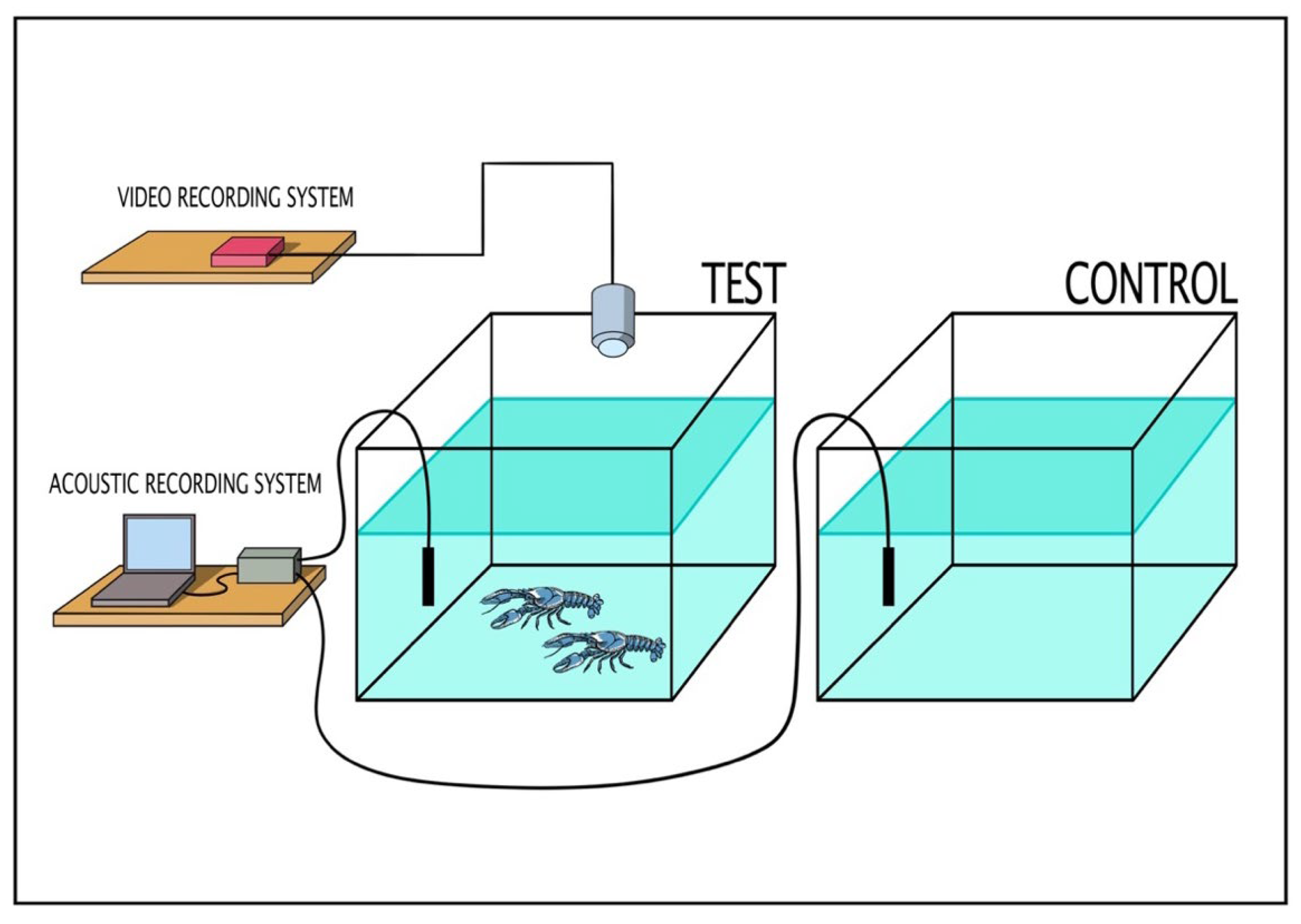

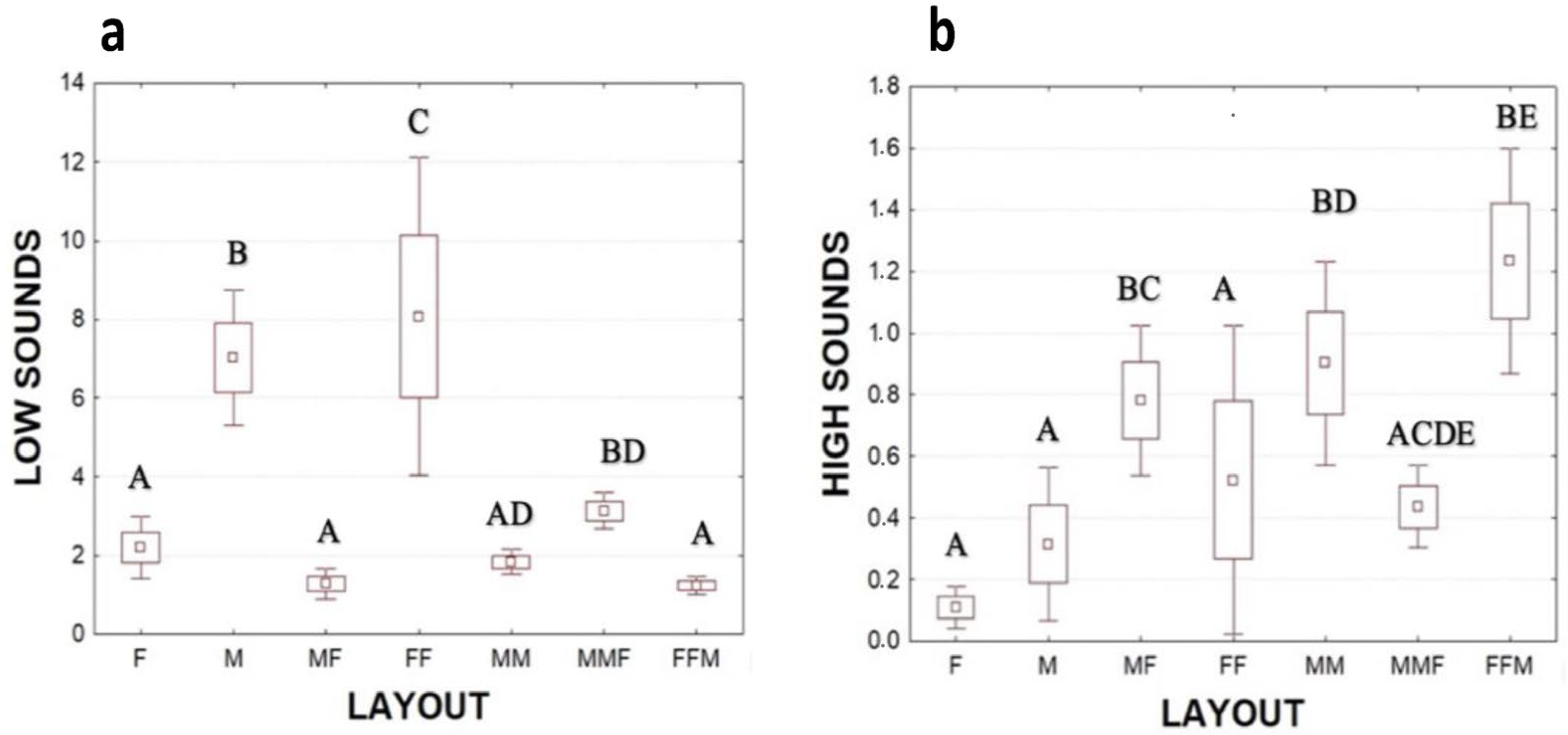

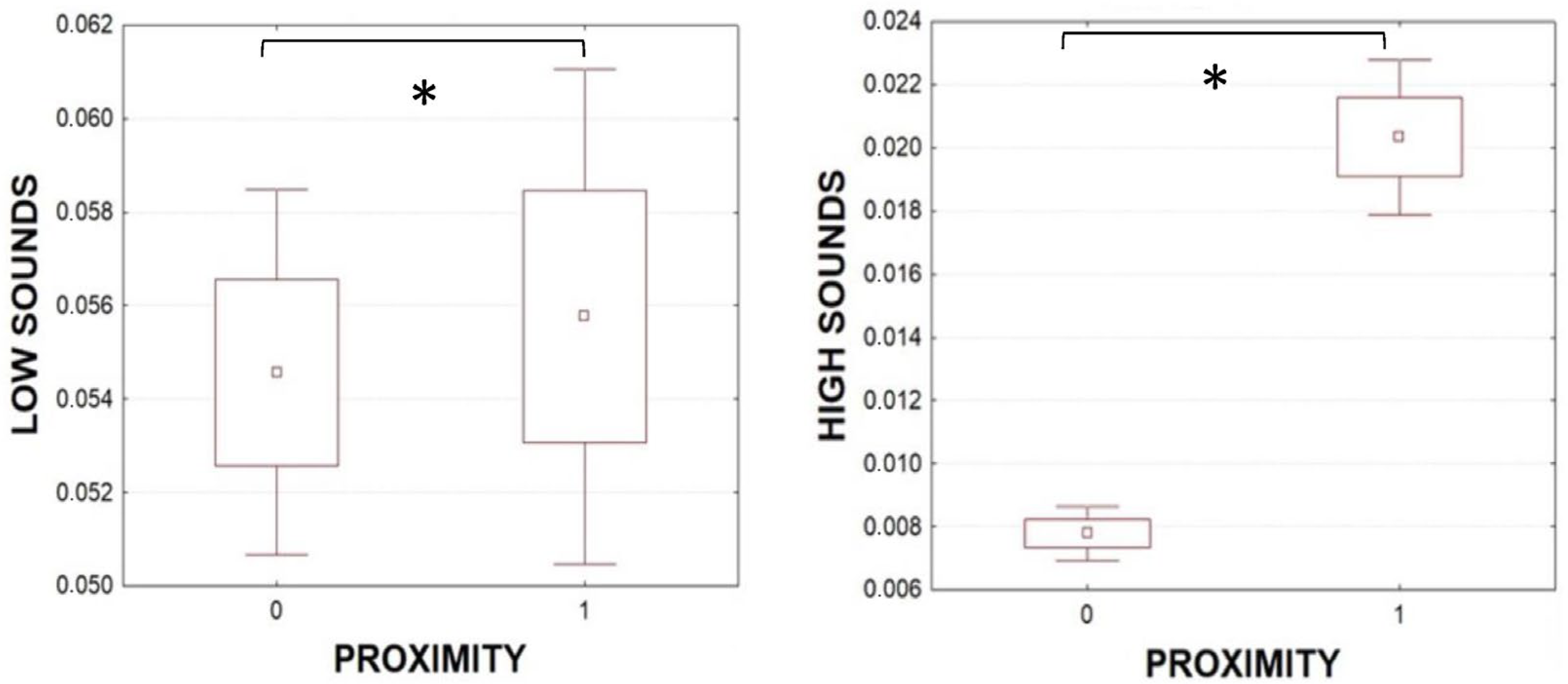
| Test Setting | Test Layout | Number of Replicas | Hours of Acoustic and Video Monitoring, h: min |
|---|---|---|---|
| single | M | 5 | 3:45 |
| F | 5 | 3:45 | |
| group | F + F | 3 | 2:15 |
| M + M | 3 | 2:15 | |
| M + F | 3 | 2:15 | |
| M + M + F | 3 | 2:15 | |
| F + F+ M | 3 | 2:15 | |
| total | 25 | 18:45 |
| Behavior Name | Behavior Description | Image | |
|---|---|---|---|
| Events | Acoustic signal | Number of impulses per specimen per trial (45 min). Using the first frequency peak, sounds were divided in two categories: high sounds with a peak frequency higher than 20 kHz and low sounds with a peak frequency lower than 20 kHz. | Hight sound  |
Low sound 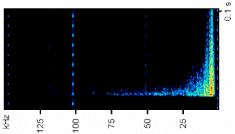 | |||
| Tail flip | The tail flip is a typical avoidance behavior consisting of a rapid abdominal flexion leading to a new position away from the opponent [39]. |  | |
| Encounters | When one specimen approached, touching another without showing any menace. |  | |
| Fights | The approach between two or more specimens that continued in a series of competitive activities [61]. | 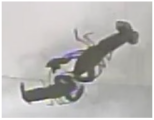 | |
| States | Fights duration (s) | The duration in seconds of the fight. | |
| Velocity of movement (cm/s) | Distance moved from the center point of the subject in the unit of time (averaged every 2 s). | ||
| Distance moved (cm) | The cumulative distance traveled by the central point of the subject from the previous sample to the current one (assessed every 2 s). | 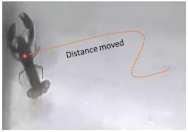 | |
| Angular velocity (Deg/s) | Change in direction of the longitudinal axis in the unit of time. | 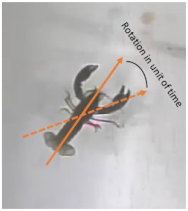 | |
| Distance among specimens—proximity | Distance of the center of the body of one crayfish to the other. If the proximity was 1, this distance was ≤ 6 cm. The proximity was 0 if the distance > 6 cm. | 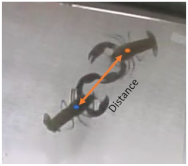 | |
| Walking | Yabby uses its legs to move itself to another location. This state was assessed only when there was a sound emission (2 s before and 2 s after sound emission). | ||
| Resting | Yabby maintains its position. This state was assessed only when there was a sound emission (2 s before and 2 s after sound emission). |
| Layout | High-Frequency Sound, Total No. | High-Frequency Sound per Specimen and per Replica (Mean ± SE) | Low-Frequency Sound, Total No. | Low-Frequency Sound per Specimen and per Replica (Mean ± SE) | Total Emission, High- and Low- Frequency Sound | |
|---|---|---|---|---|---|---|
| Single | F | 13 | 2.6 ± 1.24 | 243 | 48.60 ± 18.69 | 256 |
| M | 34 | 6.8 ± 5.58 | 806 | 161.2 ± 49.9 | 840 | |
| Group | MM | 120 | 20 ± 4.75 | 249 | 41.5 ± 7.12 | 369 |
| FF | 69 | 11.5 ± 4.43 | 1066 | 177.66 ± 37.02 | 1135 | |
| MF | 103 | 20.66 ± 6.91 | 169 | 29.16 ± 6.11 | 272 | |
| MMF | 86 | 9.55 ± 3.88 | 518 | 68.4 ± 7.75 | 604 | |
| FFM | 228 | 25.31 ± 9.10 | 225 | 25.10 ± 0.64 | 453 |
Disclaimer/Publisher’s Note: The statements, opinions and data contained in all publications are solely those of the individual author(s) and contributor(s) and not of MDPI and/or the editor(s). MDPI and/or the editor(s) disclaim responsibility for any injury to people or property resulting from any ideas, methods, instructions or products referred to in the content. |
© 2023 by the authors. Licensee MDPI, Basel, Switzerland. This article is an open access article distributed under the terms and conditions of the Creative Commons Attribution (CC BY) license (https://creativecommons.org/licenses/by/4.0/).
Share and Cite
De Vita, C.; Mauro, M.; Vazzana, M.; Arculeo, M.; Arizza, V.; Ceraulo, M.; Buscaino, G. Acoustic Signals and Behavior of the Invasive Freshwater Crayfish Cherax destructor (Clark, 1936). J. Mar. Sci. Eng. 2023, 11, 1147. https://doi.org/10.3390/jmse11061147
De Vita C, Mauro M, Vazzana M, Arculeo M, Arizza V, Ceraulo M, Buscaino G. Acoustic Signals and Behavior of the Invasive Freshwater Crayfish Cherax destructor (Clark, 1936). Journal of Marine Science and Engineering. 2023; 11(6):1147. https://doi.org/10.3390/jmse11061147
Chicago/Turabian StyleDe Vita, Clarissa, Manuela Mauro, Mirella Vazzana, Marco Arculeo, Vincenzo Arizza, Maria Ceraulo, and Giuseppa Buscaino. 2023. "Acoustic Signals and Behavior of the Invasive Freshwater Crayfish Cherax destructor (Clark, 1936)" Journal of Marine Science and Engineering 11, no. 6: 1147. https://doi.org/10.3390/jmse11061147
APA StyleDe Vita, C., Mauro, M., Vazzana, M., Arculeo, M., Arizza, V., Ceraulo, M., & Buscaino, G. (2023). Acoustic Signals and Behavior of the Invasive Freshwater Crayfish Cherax destructor (Clark, 1936). Journal of Marine Science and Engineering, 11(6), 1147. https://doi.org/10.3390/jmse11061147







